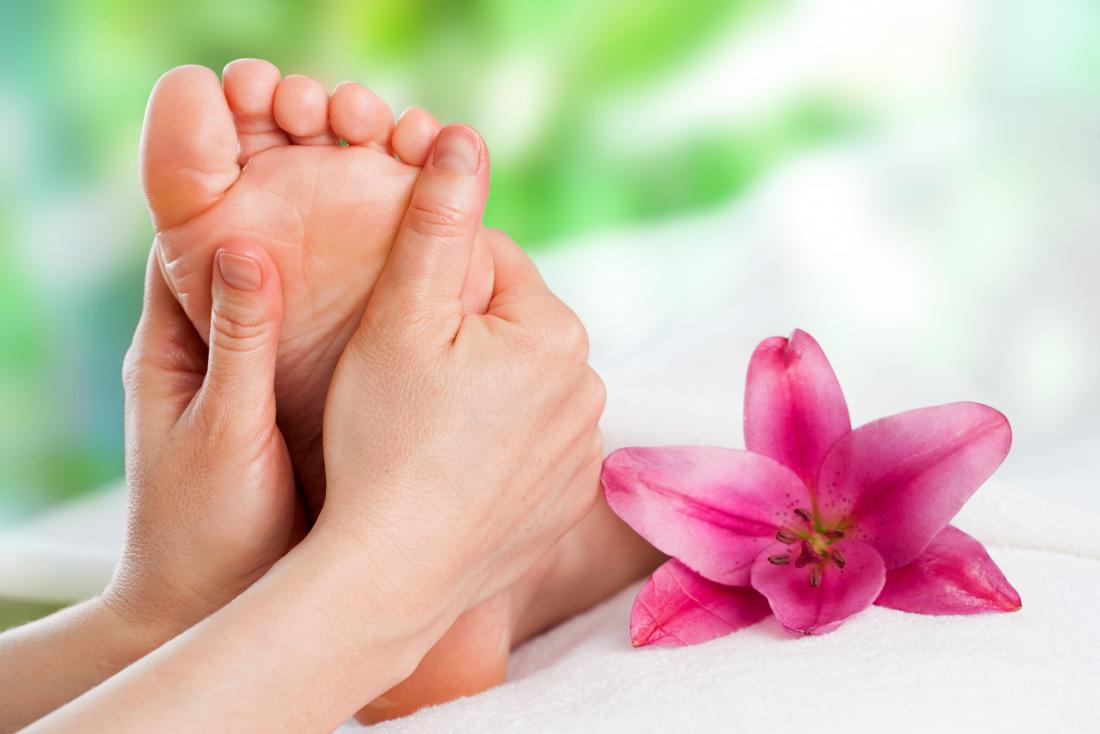This Site Is A Participant In The Amazon Services LLC Associates Program. We may earn money or products from Amazon or the companies mentioned in this post.
Foot massage has been used for centuries as a way to relieve stress and tension. Reflexology is a type of foot massage that uses pressure and stimulation on specific points on the feet, which are believed to be connected to other parts of the body. While there are many benefits to reflexology, there are also some risks that should be considered before trying it.
Foot massages are one of the most popular types of massage, and for good reason! They can be incredibly relaxing and may even provide some health benefits. However, there are also some risks associated with foot massages.
Here’s what you need to know about the benefits and risks of reflexology.
Reflexology is an alternative medicine technique that involves applying pressure to specific areas of the feet, hands, or ears. Proponents claim that this practice can promote healing in other parts of the body.
There is some scientific evidence to support these claims, but more research is needed.
There are a few potential benefits of reflexology:
1. Relief from pain and tension headaches: One study found that reflexology was effective in reducing pain and tension headaches.
2. Reduced stress and anxiety: Reflexology has been shown to help reduce stress and anxiety levels in several studies.
3. improved circulation: Massaging the feet can help improve circulation throughout the body. This is especially beneficial for people who have diabetes or peripheral artery disease (PAD).
4. Better sleep: Several studies have found that reflexology can help improve sleep quality.
What is Foot Reflexology – Foot Massage And Benefits – How to do Foot Reflexology Step By Step
Is Foot Reflexology Healthy?
Foot reflexology is a type of massage that involves applying pressure to specific areas on the feet. This is said to be beneficial for various health conditions, including headaches, back pain, and anxiety. Some research suggests that foot reflexology may also be helpful in treating digestive issues such as constipation and indigestion.
While there is some evidence to support the benefits of foot reflexology, more research is needed before any definitive claims can be made. That being said, many people report feeling relaxed and refreshed after a session of foot reflexology, so it may be worth trying if you are looking for a new way to relax.
Who Shouldn’T Reflexology?
While reflexology is generally considered a safe and beneficial therapy, there are certain groups of people who should not receive reflexology treatments. These include:
-People with active cancer: Reflexology can cause the body to release toxins, which can be harmful to someone undergoing cancer treatment.
-People with infectious diseases: Since reflexology involves applying pressure to the hands and feet, it can spread infection if the person receiving the treatment has an open wound or sore.
-People with blood clotting disorders: Reflexology can cause bruising, so it is not recommended for people who are at risk for developing blood clots.
-Pregnant women: Some experts believe that reflexology can cause contractions, so it is best to avoid during pregnancy.
Can You Feel Ill After Reflexology?
Yes, you can feel ill after reflexology. It is possible to experience a variety of side effects after reflexology, ranging from mild to severe. The most common side effect is feeling dizzy or lightheaded.
Other potential side effects include: headaches, nausea, vomiting, fainting, and fatigue. While these side effects are typically mild and resolve on their own, more serious reactions have been reported in rare cases. If you experience any severe side effects after reflexology, seek medical attention immediately.
Can Reflexology Cause Blood Clots?
There is no scientific evidence to suggest that reflexology can cause blood clots. However, as with any massage therapy, there is a risk of developing a blood clot if you have a pre-existing condition that makes you susceptible to them. If you are concerned about this, please consult your doctor before booking a session.

Credit: www.medicalnewstoday.com
Foot Reflexology Benefits
There are many benefits to foot reflexology, including improved circulation, reduced stress, and increased relaxation. This therapy dates back thousands of years and is based on the principle that there are reflex points in the feet that correspond to different organs and systems in the body. By applying pressure to these points, it is possible to promote healing and improve overall health.
One of the most significant benefits of foot reflexology is improved circulation. This can be beneficial for those who suffer from conditions such as cold feet or Raynaud’s disease, which cause blood vessels to constrict and reduce blood flow. Reflexology can also help to improve circulation in general by stimulating the nervous system and promoting Relaxation.
Reduced stress is another common benefit of foot reflexology. This is likely due to the fact that this therapy can help to induce a state of deep relaxation. When the body is relaxed, it is better able to cope with stressors, both physical and psychological.
In addition, reflexology can help to release tension from muscles that may be contributing to feelings of stress or anxiety.
Finally, foot reflexology can also promote a sense of general wellbeing by helping to balance the body’s energy levels. It is believed that this therapy can encourage the flow of chi or life force energy throughout the body, leading to a sense of harmony and peace.
Reflexology Side Effects
There are a few potential reflexology side effects that you should be aware of before you book your first session. While reflexology is generally considered to be a safe therapy, there are still some risks involved. Here’s what you need to know about the potential reflexology side effects:
1. bruising – Because reflexology involves applying pressure to specific points on the feet, it’s possible that you may bruise in the area where the pressure was applied. This is usually not a serious problem and the bruises will eventually disappear. However, if you have any concerns, be sure to speak with your reflexologist beforehand.
2. soreness – It’s also common to feel some soreness in the feet after a reflexology session. This is perfectly normal and usually goes away within a day or two. If the soreness persists or is particularly severe, consult with your reflexologist or doctor.
3. dizziness – In rare cases, some people may experience dizziness after a reflexology session. If this happens, lie down and rest until the feeling passes. If it doesn’t pass after a few minutes or if you feel faint or nauseous, call 911 immediately as these could be signs of something more serious such as low blood sugar levels (hypoglycemia).
What Does It Mean When a Reflexology Point Hurts
There are a few different things that could be going on when you experience pain in a reflexology point. It could be that the point is particularly sensitive, or there could be an underlying issue causing the pain.
If the pain is sharp and only lasts for a few seconds, it’s likely that the point is just sensitive.
This is normal and nothing to worry about. However, if the pain is more dull and lingers for a longer period of time, there may be an issue with your health that’s causing the discomfort.
There are over 7,000 nerve endings in our feet, so it’s no wonder that they can be pretty darn sensitive!
If you’re new to reflexology, it’s important to go slowly and give your body time to adjust. Once you get used to the pressure, you shouldn’t feel any pain at all.
If you’re experiencing pain in a reflexology point, it’s best to consult with a professional to find out what might be going on.
They’ll be able to help you determine whether there’s an underlying issue or if it’s just something that will go away with time.
Foot Reflexology Massage
Foot reflexology is a type of massage that involves applying pressure to specific points on the feet. These points are believed to correspond to different parts of the body, and stimulating them is thought to provide health benefits.
Foot reflexology is said to be beneficial for a number of conditions, including stress, headaches, digestive issues, and pain relief.
It may also promote relaxation. While there is some scientific evidence to support these claims, more research is needed.
If you’re considering trying foot reflexology massage, it’s important to choose a qualified practitioner who has received training in this technique.
It’s also important to let your practitioner know if you have any medical conditions or are pregnant, as foot reflexology massage may not be suitable for everyone.
Self Foot Massage Pressure Points
There are numerous pressure points on your feet that can provide relief from various ailments. By massaging these pressure points, you can improve your overall health and well-being.
One of the most important pressure points on your feet is located in the center of the arch.
This point is known as the three yin intersection and it is responsible for promoting energy flow throughout the body. Massaging this point can help to improve circulation and relieve pain.
Another important pressure point is located on the inside of the ankle.
This point is known as the spleen 6 and it helps to regulate blood sugar levels. Massaging this point can help to control diabetes and improve digestive health.
The big toe is also home to a number of important pressure points.
The first one is located at the base of the toe and it helps with joint pain relief. The second one is located at the top of the toe and it helps with headaches. The third one is located in between the two bones that make up the big toe joint and it helps with anxiety relief.
Conclusion
Foot massage reflexology is an ancient practice that has been used for centuries to promote relaxation and well-being. However, there are some risks associated with this therapy, so it is important to be aware of them before you book a session. The most common risk is developing bruises or pain in the feet from the pressure of the massage.
It is also possible to develop an infection if the therapist does not maintain sterile conditions. Finally, some people may experience dizziness or lightheadedness after a reflexology session, so it is important to drink plenty of water and avoid driving or operating heavy machinery for at least 24 hours afterwards.

Amelia Varley is a professional beauty blogger and freelance writer with a passion for all things skincare, makeup, and holistic wellness. With years of experience in the beauty industry, Amelia shares expert tips, product reviews, and innovative beauty routines with her readers. Her writing is driven by a desire to empower people to look and feel their best through mindful beauty practices. When she’s not writing, Amelia enjoys experimenting with the latest beauty trends and exploring the connection between self-care and confidence.

